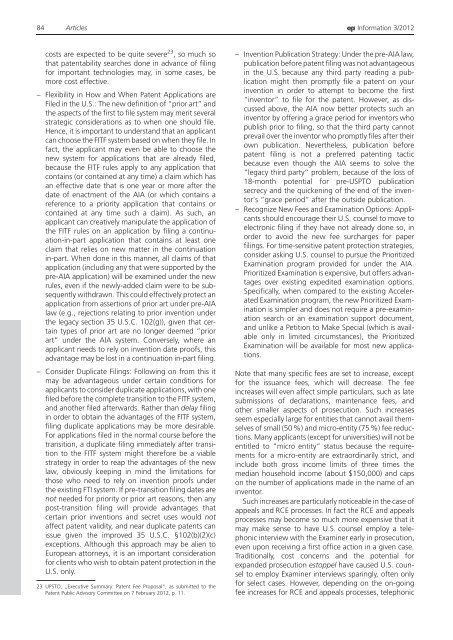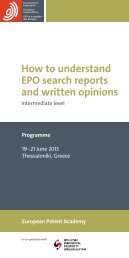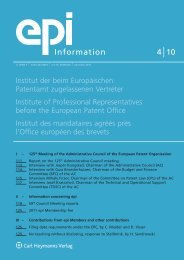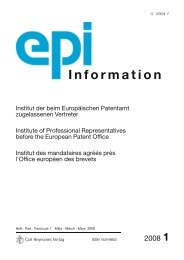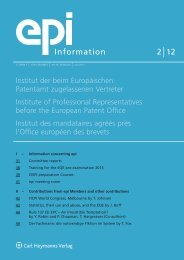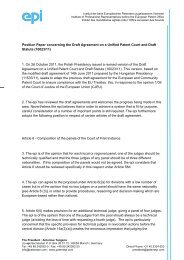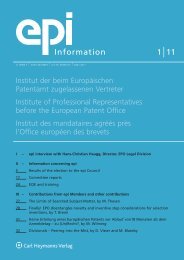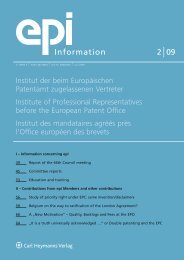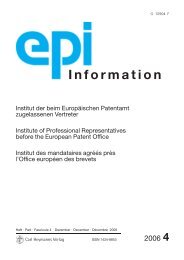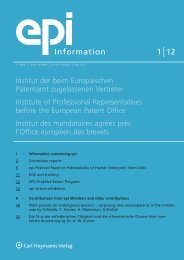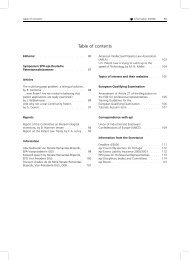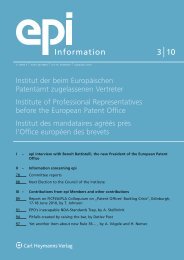Create successful ePaper yourself
Turn your PDF publications into a flip-book with our unique Google optimized e-Paper software.
84 Articles Information 3/2012<br />
costs are expected to be quite severe 23 , so much so<br />
that patentability searches done in advance of filing<br />
for important technologies may, in some cases, be<br />
more cost effective.<br />
– Flexibility in How and When <strong>Patent</strong> Applications are<br />
Filed in the U.S.: The new definition of “prior art” and<br />
the aspects of the first to file system may merit several<br />
strategic considerations as to when one should file.<br />
Hence, it is important to understand that an applicant<br />
can choose the FITF system based on when they file. In<br />
fact, the applicant may even be able to choose the<br />
new system for applications that are already filed,<br />
because the FITF rules apply to any application that<br />
contains (or contained at any time) a claim which has<br />
an effective date that is one year or more after the<br />
date of enactment of the AIA (or which contains a<br />
reference to a priority application that contains or<br />
contained at any time such a claim). As such, an<br />
applicant can creatively manipulate the application of<br />
the FITF rules on an application by filing a continuation-in-part<br />
application that contains at least one<br />
claim that relies on new matter in the continuation<br />
in-part. When done in this manner, all claims of that<br />
application (including any that were supported by the<br />
pre-AIA application) will be examined under the new<br />
rules, even if the newly-added claim were to be subsequently<br />
withdrawn. This could effectively protect an<br />
application from assertions of prior art under pre-AIA<br />
law (e.g., rejections relating to prior invention under<br />
the legacy section 35 U.S.C. 102(g)), given that certain<br />
types of prior art are no longer deemed “prior<br />
art” under the AIA system. Conversely, where an<br />
applicant needs to rely on invention date proofs, this<br />
advantage may be lost in a continuation in-part filing.<br />
– Consider Duplicate Filings: Following on from this it<br />
may be advantageous under certain conditions for<br />
applicants to consider duplicate applications, with one<br />
filed before the complete transition to the FITF system,<br />
and another filed afterwards. Rather than delay filing<br />
in order to obtain the advantages of the FITF system,<br />
filing duplicate applications may be more desirable.<br />
For applications filed in the normal course before the<br />
transition, a duplicate filing immediately after transition<br />
to the FITF system might therefore be a viable<br />
strategy in order to reap the advantages of the new<br />
law, obviously ke<strong>epi</strong>ng in mind the limitations for<br />
those who need to rely on invention proofs under<br />
the existing FTI system. If pre-transition filing dates are<br />
not needed for priority or prior art reasons, then any<br />
post-transition filing will provide advantages that<br />
certain prior inventions and secret uses would not<br />
affect patent validity, and near duplicate patents can<br />
issue given the improved 35 U.S.C. §102(b)(2)(c)<br />
exceptions. Although this approach may be alien to<br />
<strong>European</strong> attorneys, it is an important consideration<br />
for clients who wish to obtain patent protection in the<br />
U.S. only.<br />
23 UPSTO, „Executive Summary: <strong>Patent</strong> Fee Proposal“, as submitted to the<br />
<strong>Patent</strong> Public Advisory Committee on 7 February 2012, p. 11.<br />
– Invention Publication Strategy: Under the pre-AIA law,<br />
publication before patent filing was not advantageous<br />
in the U.S. because any third party reading a publication<br />
might then promptly file a patent on your<br />
invention in order to attempt to become the first<br />
“inventor” to file for the patent. However, as discussed<br />
above, the AIA now better protects such an<br />
inventor by offering a grace period for inventors who<br />
publish prior to filing, so that the third party cannot<br />
prevail over the inventor who promptly files after their<br />
own publication. Nevertheless, publication before<br />
patent filing is not a preferred patenting tactic<br />
because even though the AIA seems to solve the<br />
“legacy third party” problem, because of the loss of<br />
18-month potential for pre-USPTO publication<br />
secrecy and the quickening of the end of the inventor’s<br />
“grace period” after the outside publication.<br />
– Recognize New Fees and Examination Options: Applicants<br />
should encourage their U.S. counsel to move to<br />
electronic filing if they have not already done so, in<br />
order to avoid the new fee surcharges for paper<br />
filings. For time-sensitive patent protection strategies,<br />
consider asking U.S. counsel to pursue the Prioritized<br />
Examination program provided for under the AIA.<br />
Prioritized Examination is expensive, but offers advantages<br />
over existing expedited examination options.<br />
Specifically, when compared to the existing Accelerated<br />
Examination program, the new Prioritized Examination<br />
is simpler and does not require a pre-examination<br />
search or an examination support document,<br />
and unlike a Petition to Make Special (which is available<br />
only in limited circumstances), the Prioritized<br />
Examination will be available for most new applications.<br />
Note that many specific fees are set to increase, except<br />
for the issuance fees, which will decrease. The fee<br />
increases will even affect simple particulars, such as late<br />
submissions of declarations, maintenance fees, and<br />
other smaller aspects of prosecution. Such increases<br />
seem especially large for entities that cannot avail themselves<br />
of small (50%) and micro-entity (75%) fee reductions.<br />
Many applicants (except for universities) will not be<br />
entitled to “micro entity” status because the requirements<br />
for a micro-entity are extraordinarily strict, and<br />
include both gross income limits of three times the<br />
median household income (about $150,000) and caps<br />
on the number of applications made in the name of an<br />
inventor.<br />
Such increases are particularly noticeable in the case of<br />
appeals and RCE processes. In fact the RCE and appeals<br />
processes may become so much more expensive that it<br />
may make sense to have U.S. counsel employ a telephonic<br />
interview with the Examiner early in prosecution,<br />
even upon receiving a first office action in a given case.<br />
Traditionally, cost concerns and the potential for<br />
expanded prosecution estoppel have caused U.S. counsel<br />
to employ Examiner interviews sparingly, often only<br />
for select cases. However, depending on the on-going<br />
fee increases for RCE and appeals processes, telephonic


